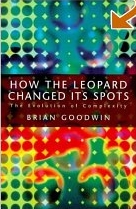Book Review: «How the Leopard Changed Its Spots: The Evolution of Complexity» by Brian Goodwin

The main theme is about how DNA doesn’t need to provide information in every detail to produce an organism. Chemical, physical and mathematical forces also play a significant part in the production of an organism. The book is also about how natural selection is not the only process at work for evolutionary advancement. I totally agree with the conclusion, and he’s sure changed my thoughts on the subject, but it was a challenge to read it all because of the way it is written. It could have been more fun.
For the others that read this book and still don’t get «how the leopard changed its spots» – its a metaphor. Leopards aren’t supposed to change their spots. The leopard symbolises scientists like Richard Dawkins and others who are fixated with genetic evolution and DNA. After reading this book, will they change their ways? Its not about leopards!
It does have loads of fascinating examples, with all the relevant diagrams & figures to make the point clear, so he’s done a good job assembling all of those. From ant colonies & the BZ reaction, to evolution of the eye & fibrillation in the human heart. An example: it is the concentration of calcium that causes the single celled organism (Acetabularia) to grow to a particular shape, NOT the DNA. He also explains why a sunflower seed head forms a spiral, and it is all to do with mathematics, nothing to do with sunflower DNA. Fascinating stuff!!
The trouble with this book is that the author uses the word «dynamic» waaaay too much. It quickly becomes very annoying. He is obsessed with that word. Open the book at random, and you will see what I am talking about. Aside from that, it is very tedious to read. Instead of making the ideas easily understood, it seems Brian Goodwin goes out of his way to make it complicated.
I’d really like to give it 3.5 stars, because at the end of it I was glad I read it, but I wouldn’t necessarily recommend it to anyone, because there are better books out there (you might like to see my other reviews on popular science books). Remember that you can only read a limited number of books in your lifetime, and this one is not perfect. Buy it ONLY if you’re specifically interested in this field of science OR you’ve read all the truly good books out there and want to lower your standards a bit and still keep reading popular science!






Discussion Area - Leave a Comment